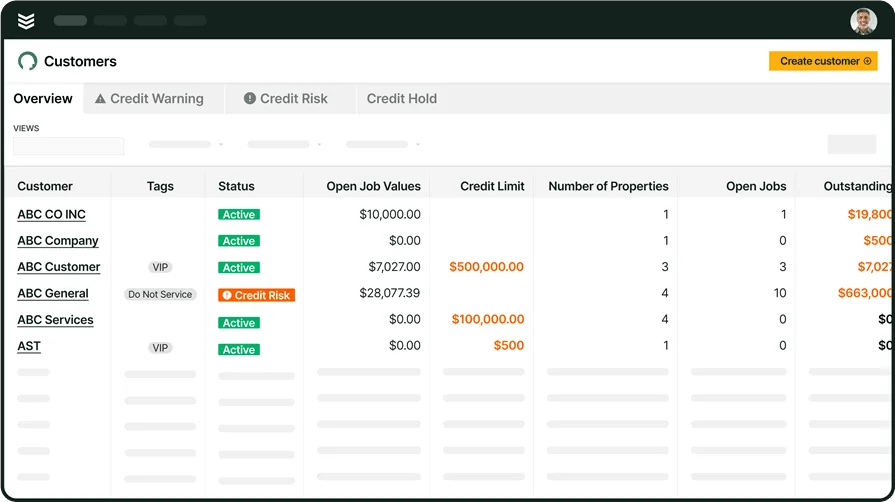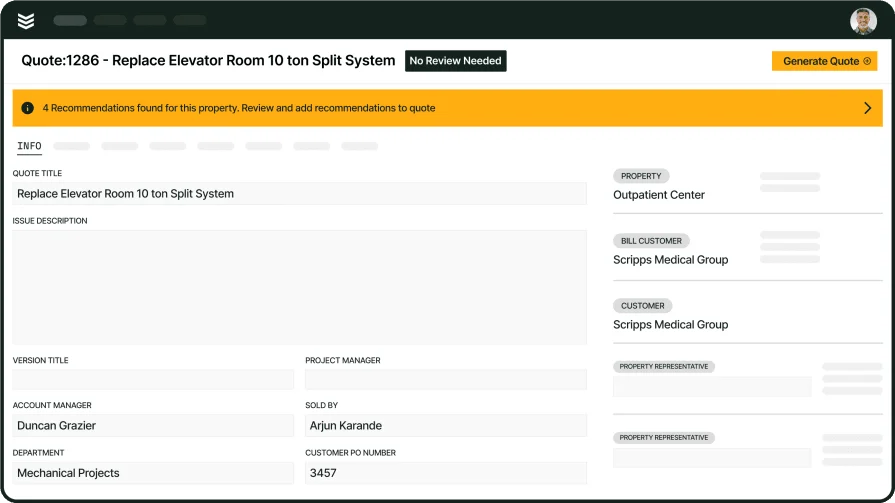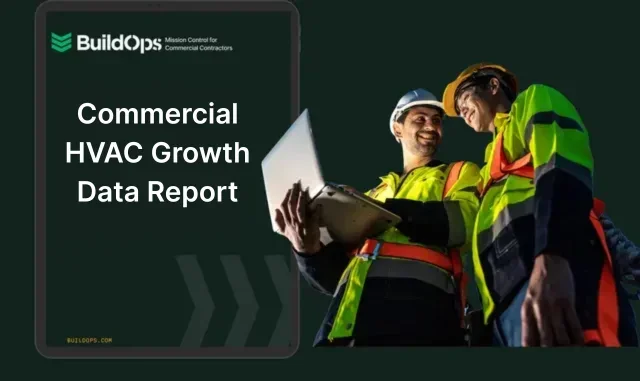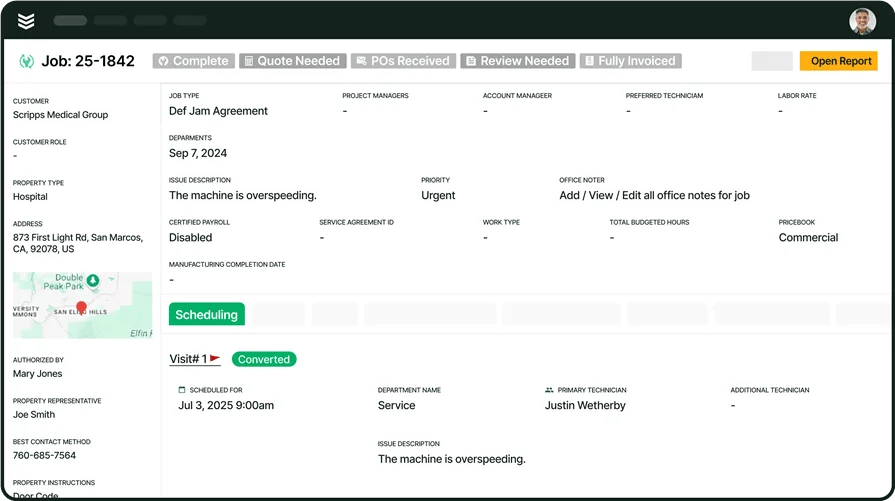Paper trails, phone tag, and cluttered whiteboards are killing productivity. If your office staff is juggling service calls, dispatching techs, and tracking down invoices—it's time to upgrade how your back office runs. HVAC office software brings everything under one roof, helping your team handle scheduling, communication, job costing, and more—without skipping a beat.
Whether you're managing a few trucks or a full fleet, HVAC office management software keeps the chaos in check so your crew stays focused on the field. These tools have become essential across the HVAC industry, especially as contractors take on bigger workloads and need tighter coordination between the field and the office. Here’s what we’ll cover:
- Choosing the right HVAC office software
- 6 key features to look for in HVAC office management software
- Best for commercial contractors: BuildOps
- Best for residential contractors: Housecall Pro
- Best for general contractors: FieldEdge
- Other notable HVAC office management software solutions
- 7 benefits of using HVAC office management software
- 4 important FAQs about HVAC office software tools answered
When your office runs like a well-oiled machine, everything else follows. But not every software is built the same—or for the same kind of shop. Whether you're focused on commercial installs, residential service calls, or a mix of both, choosing the HVAC office software that fits your workflow makes all the difference.
Choosing the right HVAC office software
Your office software should keep your entire operation—from front desk to field crew—moving without friction. It needs to handle the daily grind of dispatching, scheduling, job costing, communications, and paperwork without dragging your team down. Choosing the right HVAC office management software starts by understanding how your shop works, and where things break down most often.
Whether you’re a commercial contractor juggling multi-day installs or a residential service shop chasing back-to-back calls, your software has to bridge the gap between the folks in the office and the ones turning wrenches. These are the five areas you’ll want to evaluate first.
- Ease of setup and use - Is it simple enough for your office crew to learn fast—and flexible enough for techs in the field to use without a manual? Does the layout make it easy to find job info, customer history, or schedules without a dozen clicks? Can new hires figure it out on day one without being walked through every task?
- Fit for your workflow - Can it adapt to the way your shop already runs? Does it support commercial and residential workflows equally well? Are you able to set it up to match how your dispatcher, office manager, and field techs already communicate and operate?
- Integration and compatibility - Will it connect smoothly with your current stack—like accounting tools, CRMs, or project management platforms? Can it sync with mobile apps used by your techs in the field? If you already have scheduling tools or GPS trackers, will this software plug in or fight them?
- Support and reliability - What happens when something breaks? Can you talk to a human, or are you stuck with chatbots and email forms? Does the software company keep the platform stable and updated—or are you constantly dealing with glitches and downtime?
- Features - Does it handle everything you need in one system—scheduling, invoicing, dispatching, job costing, and reporting? Can you assign jobs, log calls, track technician hours, and manage parts ordering all in one place? Is there a mobile experience that gives field techs real-time access to the same info the office sees?
Some tools are heavy on field features but weak in the office—or vice versa. Make sure your pick supports both sides of the house, or you’ll end up juggling extra systems and more admin time. Next up, we’ll break down the specific features that make HVAC office management software worth investing in.
6 key features to look for in HVAC office management software
When the phones don’t stop ringing and the service board is packed, your office team needs more than sticky notes and spreadsheets. They need tools that talk to each other, keep jobs moving, and give everyone—from the dispatcher to the tech in the field—a clear line of sight on what’s happening. Solid HVAC office software helps your team manage the moving parts without dropping the ball.
Let’s say you’ve got three techs out in the field, and one gets tied up on a call that’s running long. Without a real-time system to adjust routes and alert customers, your day can go sideways fast. But with a good HVAC office management software, your dispatcher can reroute the next tech, update the schedule, notify the customer, and log the change—all before anyone’s even picked up the phone. Here are the six features that make that kind of coordination possible.
1. Smart scheduling tools
To stay on top of back-to-back calls, your office needs scheduling that’s fast, flexible, and built for HVAC. With scheduling software, dispatchers can drag-and-drop appointments, adjust times on the fly, and match jobs to techs based on availability, skill set, or zone.
Say it’s a busy Friday in the summer. Your team’s scrambling to juggle AC outages across town. With built-in filters and calendar views, your scheduler can spot open slots and book jobs without overlapping appointments or overloading techs—making sure every call gets handled without the chaos.
2. Real-time dispatch management
Even the best plan falls apart if you can’t adjust on the go. Field service dispatch software lets your office reroute techs, assign last-minute jobs, and see field activity in real-time.
Imagine a situation wherein a tech finishes a job early. Instead of letting them idle or calling them blindly, your dispatcher can see who’s nearby and assign the next priority call. Meanwhile, the tech gets the update straight on their app and heads to the new site with all the job info in hand—no wasted trips or back-and-forth calls.
3. CRM with service history access
Having a reliable CRM tool with customer history, asset details, and notes from past jobs gives your team a full picture before dispatching techs. No more guessing what happened last time—or which unit needs service.
Let’s say a long-time client calls about “the same issue as last year.” Instead of digging through emails, your office can pull up every visit, repair, and note. When the tech shows up, they know what to look for and what parts to bring—so the job gets fixed right the first time.
4. Fast, accurate quoting
Speed matters when it comes to closing jobs. With quoting software, your office can build estimates based on flat rates, parts catalogs, and real job data—then send quotes straight from the dashboard.
For example, a tech flags a broken compressor on-site and relays the info back to the office. Within minutes, your team pulls the right parts and pricing, builds a quote, and sends it to the customer before the tech even leaves. That kind of turnaround helps win jobs before competitors even return the first call.
5. Technician mobile access
Technician mobile apps are critical when your field team needs job info, customer notes, and work orders on the go. A good HVAC office software should sync field updates with office systems in real-time.
Think of a new tech heading to their third call of the day. With the mobile app, they see the customer’s contact info, the unit’s history, and any notes from dispatch. They can snap before-and-after photos, collect digital signatures, and log notes—all of it instantly visible back at the office. That’s one less handoff—and a lot less confusion.
6. Invoicing and payment processing
HVAC invoicing tools and payment software keep the admin side tight and cash flowing. Look for a system that lets you generate, send, and track invoices—plus accept payments online or in the field.
For instance, a tech wraps up a service call and the customer’s ready to pay. Instead of waiting on a paper invoice, the tech inputs the job details, sends the invoice to the client, and takes payment on-site with a card reader. Your office sees it hit the system in real-time, and the job’s marked complete—paid and done.

An HVAC platform built for commercial
See how BuildOps helps commercial HVAC contractors land jobs and boost profits.
Other valuable features of HVAC office software that are worth considering
While some tools are must-haves for staying on top of day-to-day operations, others can help you sharpen your edge as your business grows. These features aren’t always essential for getting started, but they can make your team faster, more organized, and easier to manage—especially if you’re scaling up or tightening your back office processes.
- Fleet tracking and vehicle data - If your team runs multiple trucks, having fleet management software that tracks locations, fuel usage, maintenance schedules, and mileage can save you from surprise breakdowns and scheduling mix-ups. It helps dispatchers make better routing decisions while keeping tabs on vehicle health over time.
- Service agreement automation - Recurring maintenance contracts are a major revenue stream. With service agreement tools, your office can track contract terms, automate renewal reminders, and generate recurring service work orders—ensuring no customer slips through the cracks.
- Pipeline visibility for sales and quoting - When your shop juggles installs alongside service calls, managing sales leads can get messy. Pipeline software gives your office a clear view of what’s quoted, what’s won, and what still needs follow-up—keeping future work from falling off the radar.
- Detailed performance and operations reporting - To make smart decisions, you need to know what’s working and what’s slowing your team down. Reporting features pull data from across your business—service trends, revenue, tech performance—and present it in digestible dashboards that help you take action, not just guess.
- Time tracking for payroll and job costing - Whether you’re billing by the hour or reviewing labor costs, time tracking software ensures hours are logged accurately. Track technician clock-ins, break times, and hours by job—then sync it with payroll or project costing for clean, reliable numbers.
Not every shop needs the same setup. Some offices are running complex commercial projects with multi-day timelines, while others are focused on fast-paced residential service. The tools you pick should match the work you do, not just check boxes on a feature list. Let’s break down which HVAC office software platforms stand out based on the kind of jobs you run.
Best for commercial contractors: BuildOps
BuildOps is tailored for commercial HVAC contractors handling complex operations and high job volume. It brings together scheduling, dispatching, job tracking, and reporting—all under one roof—so your back office runs just as efficiently as your field crew. Designed with commercial workflows in mind, the platform helps eliminate gaps between departments and keeps everyone aligned in real time.
How pricing works: BuildOps offers customized pricing based on your team size and business needs. You only pay for features that support your operation—no bloat, no unnecessary extras.
Key features that support commercial HVAC teams:
- Live job board that updates in real time
- Centralized work order and service history access
- Automated dispatch and scheduling workflows
- Job costing tools connected to time tracking and labor rates
- Custom reporting dashboards for operational visibility
What sets it apart for commercial shops: BuildOps connects the office to the field without the usual friction. Your dispatchers can update job info mid-day. Techs get real-time changes in the field. Managers see progress without needing to chase updates. Everyone stays in sync—and that means faster job closeouts, fewer delays, and tighter profit margins.

Check out BuildOps’ HVAC tool
Connect every part of your operation so your techs always have what they need.
Best for residential contractors: Housecall Pro
Image Source: Housecall Pro
Housecall Pro is a go-to platform for residential HVAC businesses looking for simplicity and speed. It covers essential tasks like scheduling, dispatching, invoicing, and taking payments—all wrapped in a clean interface that’s easy for both office staff and technicians to pick up.The mobile app updates technicians in real-time, enabling them to view jobs, message customers, and process payments remotely.
However, if your team handles high job volume, manages ongoing contracts, or works across larger service areas with multiple techs, Housecall Pro may not offer the deeper operational visibility or automation needed for long-term growth.
How pricing works: Housecall Pro offers tiered pricing, starting with core features for smaller teams and scaling up with more advanced tools as your business grows. The flexibility in plans makes it easy to start small and upgrade when needed.
Key features that support residential HVAC teams:
- Drag-and-drop calendar for quick scheduling
- Integrated credit card and ACH payments
- Customer communication tools with automated updates
- Mobile invoicing and job checklists for field techs
- Simple customer management with job history and notes
What sets it apart for residential shops: Housecall Pro focuses on speed and ease of use. It’s ideal for shops that don’t have a full office staff or want to keep admin time minimal. Everything is built to work on the go—perfect for residential techs who need access to schedules, work orders, and invoices without bouncing back to the office.
Best for general contractors: FieldEdge
Image Source: FieldEdge
FieldEdge is built for contractors who manage a mix of trades—including HVAC, plumbing, and electrical—and need a unified system to tie it all together. It supports full-cycle job management from quotes and scheduling to invoicing and performance tracking. FieldEdge helps general contractors manage projects by providing visibility into customer history, job progress, and technician availability.
That said, HVAC-focused businesses—especially those relying on detailed asset tracking, service agreements, or large-scale commercial workflows—may find FieldEdge lacking the level of HVAC-specific depth needed to manage specialized tasks efficiently.
How pricing works: FieldEdge uses a custom quote model based on business size and required features. You’ll need to speak with their team for exact pricing, but it’s designed to scale with growing service businesses.
Key features that support general contractor workflows:
- Real-time dispatching and job board visibility
- Quick quote creation and tracking
- CRM tools for managing customer interactions and service history
- Time tracking with payroll sync
- Built-in dashboards for job costing and productivity
What sets it apart for general contractors: FieldEdge helps teams balance multiple job types and trades without needing separate tools for each. It gives office managers and dispatchers the visibility they need to juggle different crews and timelines while helping techs stay informed with mobile access to job details.
Other notable HVAC office management software solutions
While the major players often dominate the conversation, there are several other HVAC office software options that serve different niches well—whether you're a lean startup, a mid-size residential outfit, or a business with highly customized workflows. Here’s a quick breakdown of five additional tools worth considering—and what to keep in mind before diving in.
Workiz
Image Source: Workiz
Workiz is a cloud-based solution that leans heavily into communication features. It’s designed to help HVAC teams manage service calls, schedule jobs, take payments, and communicate with customers all from one place. With in-app phone systems, text messaging, and online booking, it helps reduce missed appointments and keeps office staff tightly connected with the field. Their HVAC software platform highlights how automation tools like reminder texts and real-time dispatching simplify day-to-day workflows.
How pricing works: Workiz offers several pricing tiers with per-user billing, making it accessible for smaller residential teams and scalable as you grow.
Key features that support HVAC offices:
- Two-way customer messaging and call tracking
- Built-in online booking links
- Mobile app with real-time updates
- Payment collection tools
- Automation for job confirmations and reminders
Why it may not be ideal: Workiz is strong on communication and ease of use but may fall short for contractors managing multi-day commercial projects or requiring deeper integration with advanced reporting, inventory, or custom workflows.
FieldPulse
Image Source: FieldPulse
FieldPulse is tailored for small to mid-sized HVAC contractors looking for quick setup and mobile-first features. The platform supports quoting, job tracking, customer management, invoicing, and time tracking—all from an interface built with technicians in mind. Its HVAC-R solution promotes flexibility in the field and a clean dashboard for office admins who need to schedule and assign work on the fly.
How pricing works: FieldPulse offers a flat monthly base rate with additional charges per user, allowing you to customize your plan to your team’s size.
Key features that support HVAC offices:
- Mobile quoting and invoicing
- Integrated time cards and GPS tracking
- CRM with customer notes and history
- Simple scheduling and calendar views
- Task assignment and job progress tracking
Why it may not be ideal: While great for field service flexibility, FieldPulse lacks deeper analytics and some of the more advanced job costing features that growing commercial HVAC teams often rely on.
Jobber
Image Source: Jobber
Jobber is one of the most widely used HVAC office software platforms for residential service contractors. It handles core workflows like scheduling, CRM, invoicing, and customer communications. With a clean interface and an app that makes field updates simple, Jobber helps office staff keep jobs organized while techs handle work orders on the move. Their HVAC office management platform is designed to make running a smaller service business easier with less overhead.
How pricing works: Jobber offers three tiered plans—Core, Connect, and Grow—with pricing based on features and number of users, giving smaller shops a chance to scale at their own pace.
Key features that support HVAC offices:
- Drag-and-drop scheduling and calendar sync
- Quoting and invoicing with customer approvals
- Online booking and client portal access
- Automated reminders and follow-ups
- Field app for work order tracking and time logging
Why it may not be ideal: Jobber is great for smaller residential teams but may feel limited for shops that need complex service agreement management, asset tracking, or multi-location project visibility.
ServiceTitan
Image Source: ServiceTitan
ServiceTitan is a robust platform often used by medium-to-large HVAC companies that want powerful office and field operations under one umbrella. It includes advanced tools for scheduling, dispatching, estimating, marketing, and reporting—making it a strong option for businesses ready to invest in scaling. Their HVAC office software emphasizes process automation and real-time tracking, helping both office and field teams stay coordinated.
How pricing works: ServiceTitan requires a custom quote based on your operation’s size and needs. It’s considered a premium platform and is priced accordingly.
Key features that support HVAC offices:
- Advanced scheduling and dispatch workflows
- Integrated call tracking and marketing ROI tools
- Flat-rate price books and quoting automation
- Real-time technician tracking and mobile tools
- Custom dashboards and reporting
Why it may not be ideal: While powerful, ServiceTitan’s learning curve and cost can be a barrier for smaller HVAC shops or those without the staff to manage a complex rollout.
ThermoGrid
Image Source: ThermoGrid
ThermoGrid was built specifically for HVAC contractors, offering an all-in-one platform to help office staff manage everything from customer records to technician scheduling. It streamlines day-to-day tasks with automation tools for dispatch, quoting, invoicing, and service agreement management. The system also includes intelligent job matching based on technician skills and availability, helping reduce scheduling errors and improve job efficiency.
How pricing works: ThermoGrid uses a custom pricing model based on company size and selected features. Demos are available, but pricing is typically aimed at mid-size operations and up.
Key features that support HVAC offices:
- Smart dispatch with skill-based job matching
- Automated quoting and invoicing workflows
- CRM with full service history and contact logs
- Recurring service plan management
- Integrated reporting and analytics
Why it may not be ideal: While ThermoGrid offers HVAC-specific tools, its interface isn’t as modern or intuitive as some newer platforms, which may slow down onboarding for office teams used to more polished software environments.

Get the HVAC Growth Report
Find out how leading HVAC contractors grow their business and boost profits.
7 benefits of using HVAC office management software
When your office runs on software built for the trades, the entire operation benefits—less chaos, more visibility, and better outcomes for both techs and customers. HVAC office management software connects the dots between scheduling, quoting, dispatching, and invoicing so your team isn’t stuck chasing info or correcting mistakes. Here’s how it pays off in the real world, with context grounded in everyday HVAC work.
1. Keeps field and office teams in sync
A well-connected system means dispatchers, office admins, and field techs are always looking at the same job data. No miscommunication, no back-and-forth texts just to confirm addresses or timelines. This type of workflow is a key piece of effective HVAC field service management, where every delay in communication can slow down an entire day’s schedule.
2. Reduces dispatching mistakes
Misassigned techs or double-booked jobs often come down to office tools that lack visibility. Software designed for dispatch helps teams avoid those mistakes by matching jobs with technician availability, skill sets, and location. It’s one of the reasons many HVAC contractors reevaluate how they handle HVAC dispatch operations—because better tools lead to better decisions.
3. Shortens your billing cycle
Delays in invoicing usually come from manual handoffs—notes that don’t get logged or jobs that aren’t marked complete in time. HVAC office software removes those barriers by syncing field updates with office billing systems. This tighter workflow reflects what’s covered in the HVAC invoicing guide, especially when faster cash flow becomes a priority for service-heavy businesses.
4. Makes estimating more accurate
When quotes are built from actual job history, labor rates, and part costs, they tend to reflect reality—not guesswork. HVAC office tools centralize those numbers so estimators can build faster, more reliable bids. It supports the kind of consistency discussed in the HVAC bidding guide, where accuracy directly impacts win rates and profit margins.
5. Improves customer communication
Customers want updates. Office staff want fewer phone calls. HVAC office management tools help bridge the gap by automating confirmations, reminders, and follow-ups—without needing to manually track each message. Tools like HVAC CRM software are built to manage that communication flow so everyone stays in the loop, automatically.
6. Empowers dispatchers to make better calls
The difference between scrambling and staying ahead often comes down to how much your dispatcher can see. Live technician status, job durations, and priority levels give them everything they need to make confident decisions. That level of control is something emphasized in the HVAC dispatcher role, where visibility is essential to daily success.
7. Helps you scale without losing control
As your business grows, more techs, trucks, and jobs can strain your systems—unless they’re built to scale. HVAC office software helps maintain consistency across workflows, giving your team a clear process no matter how big things get. It ensures growth doesn’t come at the cost of coordination.
4 important FAQs about HVAC office software tools answered
Selecting HVAC office software isn't a simple checklist exercise; it's about discovering the ideal digital partner that aligns perfectly with your unique business operations. Whether you're a service manager trying to cut down on double-bookings or an owner wondering what to budget for, these are the questions contractors ask most when weighing their options.
1. What is HVAC office management software?
HVAC office management software helps manage scheduling, dispatching, customer records, quoting, invoicing, and internal communication between the office and the field. It serves as a centralized hub where job updates, technician availability, and customer information are connected and up to date.
It centralizes your daily operations so that your team isn’t juggling multiple spreadsheets, calendars, and text threads just to keep up. From assigning jobs to tracking time and managing service agreements, it helps streamline how the office and field teams work together—especially in busy HVAC environments.
2. How much does HVAC office software usually cost?
Most platforms offer pricing based on the number of users, features, or both. You’ll typically find monthly rates starting around $30–$50 per user for basic tools and scaling into the hundreds for larger commercial operations. While some providers offer tiered subscription plans, the majority of HVAC office software companies prefer custom pricing models tailored to the specific needs, team size, and workflows of each customer. This helps ensure you’re only paying for the tools that actually support your operation.
3. Can HVAC office software be customized for my business?
Yes—many platforms offer customizable workflows, job types, forms, permission settings, and even branded customer-facing documents. Higher-end systems allow you to tailor dashboards, set role-based access for your team, and adjust how job data flows through each stage of a service call. It’s worth prioritizing this if your processes aren’t one-size-fits-all.
4. What are some best practices for getting started with HVAC office software?
Rolling out a new HVAC office management platform doesn’t have to be overwhelming—especially if you take a structured approach. Following a few best practices early on can help your team hit the ground running, avoid unnecessary headaches, and get real value out of the system right away.
- Identify your current workflow gaps before choosing a platform—know what’s breaking down so you can fix the right things
- Get buy-in from both office staff and field techs—everyone who touches the system should feel part of the process
- Start with core features like scheduling and dispatch, then expand into quoting, reporting, or service agreements
- Map out your process flow—from call intake to payment—and look for ways to tighten it within the software
- Use role-based permissions so teams only see the features they need, cutting down on clutter and confusion
- Clean up your data ahead of time—import only what you need and organize customer records before go-live
- Schedule dedicated onboarding time with your software provider, not just a quick demo or tutorial
- Set clear internal goals and timelines so adoption doesn’t drag—make it part of your team’s weekly routine
- Monitor usage in the first few weeks to catch bottlenecks or questions early before bad habits set in
- Keep a direct line open with your software’s support team—they can help you tweak things to match how your shop runs
These steps not only ease the transition but also help you get the most from your HVAC office software investment right from the start.
Office chaos doesn’t have to be part of the job. Whether you're trying to keep service calls on track, dispatch the right techs, or close out jobs without a paper trail, the right HVAC office software brings order to the noise. It's not just about digital tools—it’s about giving your back office the control and clarity it needs to support the field without missing a beat.
Each solution in this guide offers something different, depending on the size of your team, the kind of work you do, and how your operation is set up. For residential shops, lightweight tools with mobile access can make life easier. For larger commercial contractors, platforms like BuildOps deliver an all-in-one system to manage service workflows, track job progress, and keep both the field and the office fully aligned.

Curious how BuildOps works?
We help HVAC contractors keep techs in the field connected to the office.







